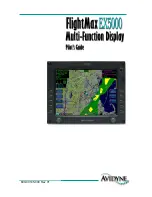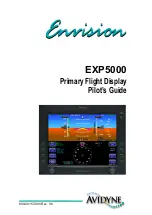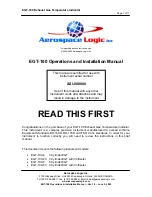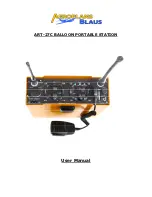
FMA Direct
17
Co-Pilot II reference manual
General flying information
Note:
This section discusses unique aspects of flying with Co-
Pilot™ II. It is not a substitute for flight instruction from an experi
-
enced pilot.
n
If you are a beginner, obtain help from an experienced mod-
eler. Co-Pilot II makes it easier to learn to fly, but it cannot
teach you how to fly—only an experienced flyer can do that.
n
Co-Pilot II cannot correct for reversed controls, binding link-
ages, a balky engine or any other problems. Make certain
your entire radio system is properly installed and working cor-
rectly before flying. Be sure your aircraft is airworthy. If the
airplane hasn’t been flown before, have a qualified pilot check
it out—on the ground and in the air.
n
Flying with Co-Pilot II is different from normal flying. When
Co-Pilot II is on, it is always attempting to keep the aircraft
level. You’ll need to provide more stick motion to override
this tendency. This is great for beginners, but experienced pi-
lots will want to tailor performance by adjusting stick priority
and/or reducing gain settings.
n
Initial flight tests, adjustments and trimming should be done
by an experienced pilot.
n
If you can control Co-Pilot II with your transmitter, you can
have the best of both worlds: turn Co-Pilot II on when you
need it, turn it off when you don’t. Or use Co-Pilot II as a
“panic button” to quickly recover the aircraft from an unusual
attitude.
n
If you notice the aircraft shaking or oscillating while it is air-
borne, Co-Pilot’s gain is set too high. Land the aircraft and
use the IRNet Programmer to reduce gain.
n
Increase gain on windy days. The aircraft will fly more
smoothly.
n
Don’t attempt intentional aerobatic flight until you gain expe
-
rience. If the Vertical Sensor Module is not installed, Co-Pilot
II reacts to inverted flight by applying full up elevator, which
can put the plane into a descending loop until it is upright.
Unless the plane is very high, it may crash. For aerobatic
maneuvers, turn off flight stabilization or take advantage of
Co-Pilot II’s aerobatic Flight Modes (described later in this
manual).
n
If Auto Trim is off, and if you notice a small difference in trim
when turning Co-Pilot II on and off, re-trim with Co-Pilot
II off. Adjust flight angles in the “Preferences” screens to
achieve proper trim with Co-Pilot on and off.
n
If the aircraft is flying in a narrow valley, then high terrain or
tall trees on one side will affect the average infrared radiation
on that side. Take this into account when trimming and flying.
n
It’s always a good idea to find out how your airplane handles
at low speed (do this at high altitude). This will help you get a
feel for how the plane will behave during landing. Co-Pilot II
makes landing much easier by keeping the plane level during
the approach. However, stalls are still possible at low speeds.
Flying with Co-Pilot II
Flying a conventional airplane
n
To take off with tricycle landing gear:
1. Increase throttle to begin roll-out.
2. Keep the plane moving straight with rudder.
3. Pull back on the stick (up elevator) to lift off.
n
To take off with taildragger landing gear (see explanation be-
low):
1. Apply full up elevator when taxiing and at the beginning of
takeoff.
2. Increase throttle to begin roll-out.
3. Keep the plane moving straight with rudder.
4. As the plane gains speed, ease off the elevator, but keep
enough for lift off.
Why tail-draggers handle differently with flight stabilization
Recall that flight stabilization attempts to keep the aircraft level.
While a tail-dragger’s tail wheel is on the ground, the airplane
isn’t level. Flight stabilization tries to level the plane by feeding
in down elevator. If you don’t counteract this by holding full up
elevator during ground maneuvers, the tail may come up when it
shouldn’t—causing loss of ground control.
n
To make a turn:
1. Hold aileron in the direction of the turn.
2. Apply a little up elevator to maintain altitude.
3. Center the stick (but don’t let go of the stick!) to return to
level flight.
n
To fly straight and level:
Center the stick (but don’t let go of
the stick!). You may need to adjust elevator trim to maintain
level flight. Pitch angle changes with speed, so adjust elevator
trim when you vary the throttle.
n
To recover from errors such as dives and unintended rolls:
Center the aileron/elevator stick (but don’t let go of the stick!).
Co-Pilot II takes over and levels the plane.
n
If the engine dies, apply a little down elevator to maintain air-
speed. This is especially important for sport planes.
n
To land:
1. Reduce speed and line up for the approach.
2. Push gently up on the stick (for down elevator) to reduce
altitude.
3. Over the runway, throttle down to idle.
4. Gently pull back on the stick (up elevator) to raise the nose
and slow the plane.
5. Steer the plane with rudder as it touches down.
6. For a taildragger, apply full up elevator after touchdown to
keep the tail wheel on the ground.






























